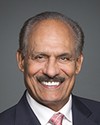Thank you, Chair.
I spent most of my professional career working on Canada-U.S. relations for 33 years as a foreign service officer, with postings in New York, Los Angeles, and Washington, and as a member of the teams that negotiated the Canada-U.S. Free Trade Agreement and then NAFTA. I've had the privilege of visiting every state in the union. I continue to be involved with the U.S. from the vantage point of business and think tankery. Let me start with a couple of observations.
First, for Canada, our international relationships will always be conditioned by our relationship with the United States. We cannot change our geography, nor would we want to. The U.S. is not only our most important ally and trading partner, but when we leverage personal relations and our role as bridge or linchpin, we also significantly enhance our diplomatic weight.
It was, for example, the U.S. that muscled us into the G7, in no small part because successive treasury secretaries, George Shultz and then Bill Simon, knew that then finance minister John Turner and external affairs minister Allan MacEachen brought value to the table. We gain when we play the role of explainer or interpreter of the U.S. to the rest of the world, especially during Republican administrations. At the same time, Allan Gottlieb observes in his Washington Diaries the starting point for anyone who wants to understand the practice of Canada-U.S. relations, namely, that when we are on our diplomatic game, our advice and insights into what the rest of the world is thinking are always welcomed by the United States.
Our smart immigration policy and the lessons of pluralism give us people-to-people links in every corner of the world to the benefit of our trade, investment, and tourism, and in marketing Canada as a place to study.
We're also a great place from which to observe and get perspective on the United States. As Paul Evans recounts in Engaging China, that fact that we were somewhat independent and that Canada could play a middle-power role in bringing China in from the cold were major factors in the Chinese decision to take advantage of Pierre Trudeau's invitation to open relations with Canada in 1971.
Other countries also appreciate the vantage point of Canada into the U.S.A. Know it or not, we get a better grade of diplomats in Ottawa than would otherwise be the case.
My second observation is equally obvious. Management of the relationship with the U.S. has become much more difficult with the Trump administration. With President Trump we encounter an administration unlike any we have encountered. It is nativist, protectionist, and unilateralist. Mr. Trump's policy of America first, buy American, and hire American is cavalier treatment of the NATO alliance and G7. With his sweeping aside of the Trans-Pacific Partnership, the European trade deal, and now the Paris climate agreement, we witness a radical departure from post-war American policies.
Mr. Trump's musings are music to the ears of Vladimir Putin and Xi Jinping, both of whom favour the return to a concert of great powers with spheres of influence. Thucydides long ago described this approach to international affairs: “the strong do what they can and the weak suffer what they must“. The Athenians, who followed that maxim, came to a bad end, having alienated all of their allies. I am confident that, with different leadership, the U.S. will return to its traditional role as the anchor of the rules-based, liberal international system. As Churchill once remarked, “You can always count on the Americans to do the right thing after they have tried everything else.”
But for now, the more America turns inward, the greater the requirement for Canada to broaden its foreign policy options and to deepen its investment in our diplomatic and defence capabilities and capacities. What middle powers like Canada cannot do is sit on the fence or play it safe. Canada, in league with other middle and like-minded powers who value representative government, human rights, and freer trade, needs to again step up and reassert our interests in sustaining and preserving the rules-based liberal international system. In practical sense, this means working in tandem with our European and Pacific partners.
Divide and conquer are key elements of Mr. Trump's art of the deal, so staying especially close with Mexico, our friend and continental partner, will be critical as we renegotiate the North America economic accord with the U.S.
Canadian policy must begin with an activist international engagement strategy, with a special focus on the U.S. while simultaneously seeking to diversify our trade. This means getting our resources to tidewater so we can access world markets and get world prices. When you only have one market, it's the buyer that sets the price. It will require investment. In dollar terms, we should set as goals of good international citizenship making a contribution of 2% of GDP to defence spending, the NATO norm, and 0.7% of GDP for development, the Pearson Commission standard. If the United Kingdom can mange it, so can we.
The Chinese use two brush strokes to write the word “crisis”. One brush stroke stands for danger, the other for opportunity. In crisis, be aware of the danger, but recognize the opportunity, so let's look at the Trump challenge as an opportunity.
Let me share with you 10 rules of the road that we Canadians should apply in managing Mr. Trump and the U.S. relationship.
One, what is our ask? What will we give? Know our facts. Messaging must be blunt and on-point, and get to the point. If at first you don't succeed, try and try again. If you still aren't getting through, change your pitch. Practice and persistence make perfect, but remember it's not a level playing field. When we play against the U.S., we have a better-than-even chance only when we are playing on ice, so we need to be very well prepared.
Two, we need to get our act together, within governments, with business, labour and civil society. The Americans will exploit our differences to our cost, as we are learning once again on softwood lumber. They will happily collect their import levy until we get our own act together. We've a good brand, but we need to develop it and use it more strategically. Keep in mind that Americans like us more than we like them, and that there are always more Americans who think like Canadians than there are Canadians. Margaret Atwood famously observed that, when Americans look north, it's like looking into a mirror. They see a reflection of themselves; we see something different, but Canadians too often define themselves by what we are not—Americans. It's an insecurity we need to get over.
Three, no surprises. Americans don't mind differences, but they don't like being blindsided, especially on security issues, like some feel we did on our participation of ballistic missile defence or on going into Iraq. The Americans don't mind our taking a different tack, but they do want clear notice. Be careful with tit-for-tat: it may get us attention, but when you threaten to pull a trigger, be prepared to pull it and then suffer the consequences. For the same reason, be very careful with linkage between issues.
Four, personal relationships are everything. We would never have had the Canada–U.S. Free Trade Agreement but for Brian Mulroney's relationship with Ronald Reagan. I applaud the efforts at the national level to have cabinet ministers and MPs from all parties travel to the U.S., especially into Trump territory, to remind their American counterparts just how much the Canadian relationship does to underpin local jobs.
The premiers and provincial legislators have a critical role. Their long-standing participation in the regional meetings of governors and state legislators are vital. For me, the best regional model is the Pacific Northwest Economic Region, PNWER, an association of business, legislators, and civil society that gets things done. The best functional model addressing supply chains in North American is NASCO. Both, incidentally, are based in the U.S. There are also a group of extremely useful trans-border business associations, like the Canadian American Business Council. At the state level the best-in-class is the Canada Arizona Business Council. Together, these assemblies of premiers, and governors, and legislators, and the regional, functional, and trans-border organizations constitute the hidden wiring that keeps our relationship greased and in working order.
Five, make it a U.S. issue and identify U.S. allies. That's how we've gotten around various Buy American restrictions. Recently, for example, the U.S. acted against aluminum imports. The target was China, but as is often the case with U.S. protectionism, we get sideswiped. We make aluminum in Quebec. The workers are members of the United Steelworkers union. The Steelworkers are advocates of Buy American, but they consider their Canadian brothers and sisters to be family, so we got an exemption. It helps that their president, Leo Gerard, is a Canadian—a reminder that we need to make use of the international union ties between Canada and the U.S.
Our networks need a thousand points of contact. Pitching is retail and a contact sport, and as an icebreaker, knowledge of U.S. college football and basketball is very useful. When I was posted in the U.S., I would tell new arrivals that a good way to meet Americans, especially in red states, was to join a church or a gun club.
Six, Ottawa does not have all the answers. The provinces have competence and experience. Trust the staff at our missions in the U.S., the embassy and our consulates, for their read of the local environment. They know a lot and have a superb Rolodex of contacts.
Seven, the administration is our entry point, but the battleground is Congress and the states. We need to devote more attention to legislators, both in Congress and in the states. When we play in the U.S., play by their rules. In a relation that transacts over $1 million a minute in trade, we need to use lawyers and lobbyists. For legislators who must fundraise daily, all politics is local: special interests, business, labour, environmentalists, minorities represented by lawyers and lobbyists fund legislators and drive domestic policies like Buy American. Protectionism is as American as apple pie, a deep-rooted political response to structural problems in the U.S. economy.
Eight, beware of noise and don't get spooked. We need to practise risk assessment and differentiate between what is real, a threat, and what is noise. A lot of what we're hearing now and what we will hear in the coming weeks of congressional hearings on NAFTA is positioning. The Americans are masters at positioning and will exercise the excitable, and give editors a daily dose of dramatic headlines. Most congressional legislation fails, but we tend to behave like Chicken Little every time we see something we don't like. Again, their system is different from ours, with checks and balances, and separation of power.
The bogeyman out there is the border adjustment tax. It's a real threat, because it is endorsed by House Speaker Paul Ryan, but the Americans also recognize that, as in physics, for every action there is a reaction. If they adopt a border tax, so will we, and so will other nations. Going down that route with Smoot-Hawley contributed to the Great Depression.
Nine, go for gold. We are better than we think we are, but there is a Canadian tendency to compromise from the outset. An admiral trait, it is a natural reflection of our national character developed to come to terms with our vast geography and harsh climate. It makes us good diplomats, but compromising before we sit down is a mistake with the Americans. We should not out-negotiate ourselves beforehand. In other words, ask for what we really want rather than what we think they will give us. Nor should we ever expect gratitude in what we think we did for them. Business is business, and the business of America is business.
Ten, it's a permanent campaign that needs all hands on deck—all levels of government, business, labour, and civil society. Canadians who have American friends and family and who spend time in the U.S. need to be enlisted. We need to engage more with Americans and start every conversation with three main messages. First, we are a reliable ally and security partner, although we do need to invest more in our armed forces. Second, we are a fair and trusted trading partner. Canada is the main market for 35 states and the second market for the rest. U.S. trade with Canada generates nine million jobs. It's more than trade. It's making things together through supply chains to our mutual advantage. My favourite factoid is that the average Canadian eats $629 worth of U.S. agrifood products annually. The average American spends $69 on Canadian agrifood products. And third, Canada is a secure, stable, and reliable source of energy. It lights up Broadway, keeps the cable cars going in San Francisco, powers the Mall of America in Minnesota, and fuels American manufacturing. With $2 billion in trade daily, Canada has only a slight surplus, because we provide 40% of U.S. energy imports. Otherwise, they enjoy the surplus.
An American ambassador once observed that Canadians think they know all about Americans, while Americans think they know all they need to know about Americans. We are both wrong. We need to know them better, because for now this relationship is asymmetrical. They matter more to us than we matter to them. For very good historical overviews, I would refer you to the good work, especially on middle powers, by Kim. I would also suggest you read Bob Bothwell's Your Country, My Country, as well as Jack Granatstein and Norman Hillmer's For Better or For Worse: Canada and the United States into the Twenty-First Century.
The rest of the world is watching how we manage Mr. Trump. We need to stick to our game, work with our partners, especially Mexico, and we will do just fine.
Thank you.




